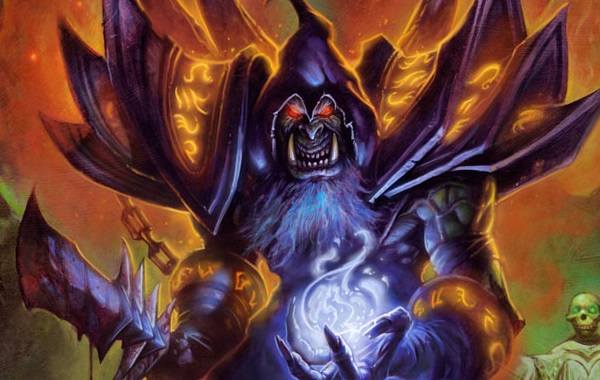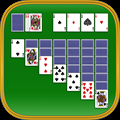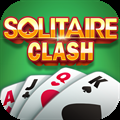
Written: Nydra and Space Monkey Follow @spc_monkey
The Warlocks behave in a unique way in how they play their most powerful cards. Craving victory at any cost, the demonic spellcasters are ready to sacrifice their hand, their minions or even their own life points to get what they want. And what they want is usually very painful to their enemies.
This suicidal playstyle of the Warlocks starts with their hero power. Life Tap allows Warlocks to draw a card at the cost of two mana and two life, a great ability that provides card advantage without taking deck slots for card-drawing spells. The ability is costly but when used right and when the cards drawn and utilized to the best of their abilities, the sacrificed life doesn’t matter as much. It’s merely another form of resource.
Life Tap is as good in aggressive decks as it is in controls. The aggro builds will use it to refill their hand (playing lots of cheap minions and having a small hand size always go together) in order to have cards to play after a board sweep. The control decks, on the other hand, will Life Tap to dig for responses and maintain their opponents’ side of the board clean.
Many of Warlock’s spells also come with similar drawbacks, i.e. they will deal damage or gain card advantage at a cheap cost but they will require something in return. Those costs range from discarding cards (Soulfire, Doomguard), paying life (Flame Imp) or sacrificing minions (Void Terror, Blood Pact). However, if those cards are played carefully (i.e. play Soulfire and Doomguard as finishers and not early in the game when the opponent can take advantage of your destroyed hand size), paying the drawback cost for them should be justified.
?
If you want to build a Warlock deck on the budget, you’ll have to go the aggro/beatdown path as the cards that control decks require like Shadowflame, Siphon Soul, Twisting Nether and Jaraxxus are all quite expensive.
The deck displayed below uses many of the cards that are core for the current tournament-winning Warlock aggros. You will need to craft sets of Blood Imp, Flame Imp, Harvest Golem and Dark Iron Dwarf but since you’ll use those for almost each one of your Warlock/non-Warlock decks it’s a good investment. The strategy is straightforward: Play minions, buff them up through Shattered Sun Cleric and Dark Iron Dward, beat your opponent down and finish him with the Dread Infernal and Stormwind Champion if he still lives till T7.
Crafting for the Warlock
I. Commons
- Blood Imp
One of the best minions right now, this small imp is a game changer. +1 toughness to all minions really matters when they have to survive opponents’ board sweepers or set up favorable trades. It’s a must have for every Warlock aggro, no question.?
- Flame Imp
The second imp of the Warlock is just as good as the Blood Imp. 3/2 for 1 mana is a great deal, as it gives you a solid body that can easily come on T1 and start applying early pressure or trade with any early game minion that the opponent can play. If you start second and coin it out together with Blood Imp, it gets to a 3/3 and becomes an even bigger threat as it’ll often trade 2-for-1.
As we established earlier, the 2 damage that you’ll suffer is a neglectable drawback. Life is another form of resource in this game and Warlock cards use it extremely efficiently.
- Demonfire
This is very versatile card as the option to become a removal or a buff makes it a solid spell for every Warlock deck. Great opening in every Warlock deck is T1 Voidwalker, buffed with T2 Demonfire. It works well with your Flame Imps (a T2 5/4 body is something very hard to deal with) and Blood Imps (if you ever need them to come out of stealth and attack).
- Power Overwhelming?
This powerful buff comes with a price – the death of the enchanted minion at the end of the turn. In many cases, though, you won't care about the drawback as you’ll either be trading the buffed minion for something bigger or dealing lethal damage (think of it as +4 damage for 1 mana deal in this case).
Power Overwhelming is also an important part for some Warlock combos. Many tournament-fit decks use it on Sylvanas to swing for 9 and steal an enemy minion at the end of turn. Slower Warlock controls, on the other hand, feed the enchanted minion to Void Terror for that extra, and now permanent, +4/+4 or sacrifice it for Shadowflame (a minimum of 5 damage to all enemy minions).
II. Rares
- Doomguard
With his great 5/7 stats, this demon is great finisher in the more aggresive Warlock decks out there. The drawback often doesn't matter because most of the time you play it it’ll either be the last card in your hand – aggro Warlocks tend to empty their hands quickly by casting a series of cheap creatures - or the last 5 damage you need to kill your enemy.
Even if you end up discarding two cards, playing Doomguard will often be a smart choice. At T5 it will trade favorably for most of what your opponent might have (those Venture Co. Mercenaries are among the few exceptions) and will help you establish board control.
- Siphon Soul
?This is an expensive removal, but if you want to play a control Warlock you should consider putting one of it in your deck. It kills every minion regardless of its power, toughness and whether or not it has divine shield on and heals you for 3 life, which might save your game or at least let you fight for another turn.
- Shadowflame
Another card, that is most likely to be played as one of but one that has great synergies in many Warlock decks. In aggro builds it's a way of catching up if the other player opens faster than you start the game from behind (a common sight in the current competitive meta). In control decks it's an extra board wipe if Hellfire and Twisting Nether aren't enough.
The big difference between Shadowflame and the other Warlock sweepers is that it will only kill one of your minions where the others are going to damage/kill everything. It’s an extra satisfaction when you have a minion buffed with Power Overwhelming to offer.
- Void Terror
This minion has the potential to become really huge if played at the correct time. Consuming your minions will give him great stats for a mid-game body and if kept alive he will easily beat the enemy down.
Void Terror’s main problem is silence. He’s also not a great tool if you’re behind and want to turn the game around as he hurts your own board and can be simply bypassed by the enemy. If he pays off he pays off big but bear in mind he’s a high risk investment.
III. Epics
- Twisting Nether
This is the most definitive board sweeper in the game. It's expensive and will clean your side of the board too but it doesn't care about the creature stats, divine shield, stealth and all the other stuff that might stop other removals.
Because of its cost, Twisting Nether is only used in heavy Warlock controls and more often than not they will run one copy of it. It comes as a late-game sweeper if Hellfire and Shadowflame have not been enough through the early/mid game and prepares a clean board for a next turn Jaraxxus.
IV. Legendaries
- Lord Jaraxxus
?The leader of the Burning Legion has the unique effect to exhnage your hero with himself, essentially healing you back up to 15 life. He'll change your hero power to “INFERNO!” which summons a 6/6 Infernal for 2 mana. He is also equipped with Blood Fury, a 3/8 weapon.
Jaraxxus is a good end of the mana curve for both aggresive and control-oriented warlock decks. The healing he provides is invaluable and so are his damage output and removal capabilities.
Bear in mind that when you play Lord Jaraxxus he counts as a minion before replacing Gul’Dan and he will be affected by secrets that trigger when a minion is played. Be on the watch for Hunter’s Snipe (4 damage) and especially for Paladin’s Repentance which will reduce Jaraxxus to 1 health.
Other than that, playing Jaraxxus is usually a game turner. Unlike other legendaries that come in the late game, he can’t be silenced or mind controlled and the utility he provides is a pain to deal with.
Advanced deckbuildingI. Aggro Warlock
This deck is one of the most popular aggro decks right now and rightfully so. It has a very low mana curve, allowing him to quickly populate the board with lots of small minions. Said minions, despite their low mana cost, are all good value and will more often than not put your opponent in a bad spot if he doesn’t deal with them quick enough.
The aggro Warlock has the potential to quickly snowball out of control and finish the opponent by T5 or T6. The basic idea is to play as many minions as possible and swing for the face. The Blood Imps and the other buffing minions (Shattered Sun Cleric, Dark Iron Dwarf, Defender of Argus), are the MVPs of the deck and will help your army escape mass removals, set up favorable trades and help towards quickening the death of the enemy.
Another great card in the deck is the cheap removal in the face of Soulfire. 4 damage at the cost of 0 mana and 2 cards is a good deal, especially when you have Life Tap to refill your hand. In the early game, Soulfire will dispose of the bigger threats or taunters and in the late game it will act as a finisher. The other main removal in the deck – Demonfire – is another great card and one that shines with its versatility.
After the initial surge from the cheap minions is over, big finishers will come in to swing for the last remaining hit points. The Argent Commanders are a must have as they will often trade two for one. Depending on playstyle (and the cards available in their collection), different Warlocks pick different minions to act as additional finishers and some run Doomguards (which essentially have no drawback if you’re empty handed), others implement Arcane Golem (a charging 4/2 for 3 mana) while third use Leeroy Jenkins (a charging 6/2 for 4 mana).
The best thing about this deck is that it’s going to win you many games (it’s often a high finisher in tournaments) while being reasonably cheap. If you have Lord Jaraxxus, Bloodmage Thalnos or Sylvanas do add them in but even without them the deck can pull off consistent results.
II. Board control Warlock
Created by Curi, the board contro Warlock follows some of the core principles of the aggro Warlock mentioned above but implements some additional removal, spellpower minions, some more card draw and end-of-the-curve legendaries.
The early game of the board control Warlock mimics the one of the aggro Lock. Board control is established by spamming cheap creatures while using early-game removals like Mortal Coil, Soulfire and Demonfire to clear the way. The Elven Archers which the aggro Lock uses alongside Knife Jugglers to maintain tempo are repaced with Novice Engineers for additional card draw. The ubiquitous buffing minions like Shattered Sun Cleric, Dark Iron Drawf and Defender of Argus are, of course, also here, as are the must-have Argent Commanders.
Where Curi's deck deviates even futher is with the single copy of Shadowflame, the inclusion of Lord Jaraxxus and the five-drops in Azure Drake and Sylvanas Windrunner.
Shadowflame in particular is one of the MVP's in this deck. A strong card by itself, the potency if this removal shines even brighter in the current competitive meta game when facing Rogue aggros or ending up in a Warlock aggro mirror is a common occurrence. Paired with buffing spells/creatures, a Shadowflamed minion will clear the enemy's board with Blood Imps/Defenders of Argus on the table and is among the strongest sweepers currently in use.
Of the two 5-drops, Sylvanas is a no-brainer. The card has been coming and going with the metagame shifts and right now, with aggro decks ruling, she's a must-have. Azure Drake has been somewhat falling out of favor in some decks (a T5 Drake can easily fall victim to a T6 Argent Commander and you've paid 5 mana to get a card) but it's another source of card draw and if it survives it will buff your removals. Jaraxxus comes in as the very late game card to finish the job if the deck hasn't killed before that.
III. Murlocs
The Murlocs are the Hearthstone tribal subtype with the most synergy between its creatures. Although all its minions are neutral and can technically fit any class, most players do run them in a Warlock deck for a couple of reasons.
One is Warloc’s hero ability Life Tap which will keep the Murlocs coming. As the tribal is more or less cheap on mana, squeezing in a Life Tap in between minion summons is easy and will keep your hand size decent.
The second reason is the Warlock-specific cards that buff the Murlocs or clear the board for their assault. Soulfire and Power Overwhelming works as early game removals and late-game finishers while the Blood Imps gives additional toughness to every minion. Like with the standard Warlock aggro, Lord Jaraxxus can be included as a late-game finisher if the aggro plan does not end up working, same with the Molten Giants.
Photo by: Hearthpwn
Druid -
Hunter - Crafting + Unleash the Hounds combo + Beast beat-down
Mage -
Paladin -
Priest -
Rogue -
Shaman - Crafting and building the mid-range control
Warlock - Crafting + Aggro Warlock + Murlocs + Board control Warlock
Warrior -













